Orpiment
Orpiment is a deep-colored, orange-yellow arsenic sulfide mineral with formula As
2S
3. It is found in volcanic fumaroles, low-temperature hydrothermal veins, and hot springs and is formed both by sublimation and as a byproduct of the decay of another arsenic mineral, realgar. Orpiment takes its name from the Latin auripigmentum (aurum, "gold" + pigmentum, "pigment") because of its deep-yellow color.
| Orpiment | |
|---|---|
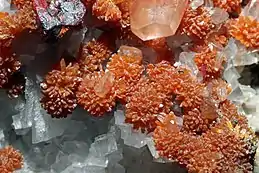 | |
| General | |
| Category | Sulfide mineral |
| Formula (repeating unit) | As2S3 |
| Strunz classification | 2.FA.30 |
| Crystal system | Monoclinic |
| Crystal class | Prismatic (2/m) (same H-M symbol) |
| Space group | P21/n |
| Unit cell | a = 11.475(5), b = 9.577(4) c = 4.256(2) [Å], β = 90.45(5)°; Z = 4 |
| Identification | |
| Color | Lemon-yellow to golden or brownish yellow |
| Crystal habit | Commonly in foliated columnar or fibrous aggregates; may be reniform or botryoidal; also granular or powdery; rarely as prismatic crystals |
| Twinning | On {100} |
| Cleavage | Perfect on {010}, imperfect on {100}; |
| Tenacity | Sectile |
| Mohs scale hardness | 1.5–2 |
| Luster | Resinous, pearly on cleavage surface |
| Streak | Pale lemon-yellow |
| Diaphaneity | Transparent |
| Specific gravity | 3.49 |
| Optical properties | Biaxial (−) |
| Refractive index | nα = 2.400 nβ = 2.810 nγ = 3.020 |
| Birefringence | δ = 0.620 |
| Pleochroism | In reflected light, strong, white to pale gray with reddish tint; in transmitted light, Y = yellow, Z = greenish yellow |
| 2V angle | Measured: 30° to 76°, Calculated: 62° |
| Dispersion | r > v, strong |
| References | [1][2][3] |
Historical uses
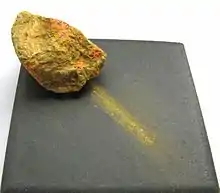
Orpiment was traded in the Roman Empire and was used as a medicine in China, even though it is very toxic. It has been used as fly poison[4] and to tip arrows with poison.[5] Because of its striking color, it was of interest to alchemists, both in China and the West, searching for a way to make gold. It also has been found in the wall decorations of Tutankhamun's tomb and ancient Egyptian scrolls, and on the walls of the Taj Mahal.[6]
For centuries, orpiment was ground down and used as a pigment in painting and for sealing wax, and was even used in ancient China as a correction fluid.[7] It was one of the few clear, bright-yellow pigments available to artists until the 19th century. However, its extreme toxicity and incompatibility with other common pigments, including lead and copper-based substances such as verdigris and azurite,[8][6] meant that its use as a pigment ended when cadmium yellows, chromium yellows and organic dye-based colors were introduced during the 19th century.
Orpiment is mentioned in the 17th century by Robert Hooke in Micrographia for the manufacture of small shot.[9]
Contemporary uses
Orpiment is used in the production of infrared-transmitting glass, oil cloth, linoleum, semiconductors, photoconductors, pigments, and fireworks. Mixed with two parts of slaked lime, orpiment is still commonly used in rural India as a depilatory. It is used in the tanning industry to remove hair from hides.
Physical and optical properties
Orpiment is a common monoclinic arsenic sulfide mineral. It has a Mohs hardness of 1.5 to 2 and a specific gravity of 3.49. It melts at 300 °C (570 °F) to 325 °C (620 °F). Optically, it is biaxial (−) with refractive indices of a = 2.4, b = 2.81, g = 3.02.
Crystal structure
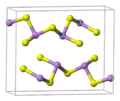
Orpiment's unit cell 
Orpiment's crystal structure consists of sheets 
The sheets are stacked into layers
Gallery of orpiment specimens
 Orpiment and realgar on a vuggy, quartz matrix, Nishinomaki Mine, Gunma Prefecture, Japan
Orpiment and realgar on a vuggy, quartz matrix, Nishinomaki Mine, Gunma Prefecture, Japan Orpiment from La Libertad, Quiruvilca, Peru
Orpiment from La Libertad, Quiruvilca, Peru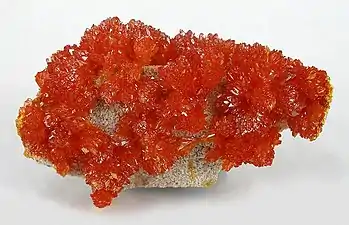 El'brusskiy arsenic mine, Kabardino-Balkarian Republic, Northern Caucasus Region, Russia
El'brusskiy arsenic mine, Kabardino-Balkarian Republic, Northern Caucasus Region, Russia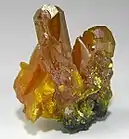 Orpiment crystal from Twin Creeks Mine, Potosi District, Humboldt County, Nevada, United States
Orpiment crystal from Twin Creeks Mine, Potosi District, Humboldt County, Nevada, United States
See also
References
- Handbook of Mineralogy
- Mindat.org
- Webmineral data
- Miller, George (1826). Popular philosophy: or, The book of nature laid open upon Christian principles, by the ed. of The Cheap magazine.
- Mesny, William (1899). Mesny's Chinese Miscellany. China Gazette Office.
- St. Clair, Kassia (2016). The Secret Lives of Colour. London: John Murray. pp. 82–83. ISBN 9781473630819. OCLC 936144129.
- Fitzhugh, E.W., Orpiment and Realgar, in Artists’ Pigments, A Handbook of Their History and Characteristics, Vol 3: E.W. Fitzhugh (Ed.) Oxford University Press 1997, p. 52
- Hooke, Robert. "Micrographia". Project Gutenberg. Retrieved 24 October 2012.
- The Merck Index: An Encyclopedia of Chemicals, Drugs, and Biologicals. 11th Edition. Ed. Susan Budavari. Merck & Co., Inc., N.J., U.S.A. 1989.
- William Mesny. Mesny’s Chinese Miscellany. A Text Book of Notes on China and the Chinese. Shanghai. Vol. III, (1899), p. 251; Vol. IV, (1905), pp. 26.
- Fitzhugh, E.W., Orpiment and Realgar, in Artists’ Pigments, A Handbook of Their History and Characteristics, Vol 3: E.W. Fitzhugh (Ed.) Oxford University Press 1997, p. 47 – 80
External links
- Webexhibits "Pigments Through the Ages: Orpiment"
- Babylonian Talmud Tractate Chullin see Rashi 'haZarnich' (in Hebrew)
- Orpiment, Colourlex
| Wikimedia Commons has media related to Orpiment. |
